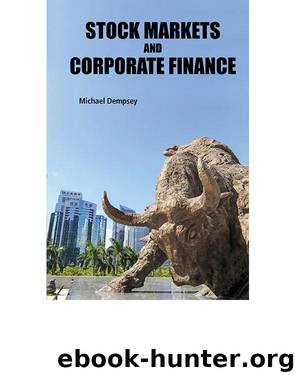Stock Markets and Corporate Finance by Michael Dempsey

Author:Michael Dempsey
Language: eng
Format: epub
Publisher: World Scientific Publishing Co. Pte. Ltd.
Published: 2018-10-13T16:00:00+00:00
7.3Ratio analysis (Table 7.4)
A ratio analysis allows for the data in the accounting statements to be aggregated in a more orderly manner. In addition, the ratios facilitate comparisons of the ratios with (i) the firm’s previously recorded ratios and (ii) the ratios of other firms in the firm’s sector.
Table 7.4: Financial ratios (for 20x1).
7.3.1The main ratios
Calculation of the ratios follows from a straightforward calculation of the definitions as revealed in Table 7.4, where the numbers are taken from either the Income (Profit and Loss) Statement (Table 7.1) or the Balance Sheet (Table 7.2). In the final column of Table 7.4, we provide supposed estimates for the average value of the ratios in the firm’s sector. We proceed to make our interpretation as follows.
PROFITABILITY
If we look at the PROFITABILITY ratios, we may have concern that each of the ratios, Net profit margin, Return on assets (ROA), and Return on equity (ROE), which is to say, Net income as a fraction of each of Sales, Total assets and Shareholders’ equity, is low compared with the industry average. The numbers imply that the firm is underperforming in terms of its ability to generate income from its productive base. (For all entries under PROFITABILITY, we interpret a larger number as “better”.)
ASSET MANAGEMENT
Inventory turnover — − is the number of times the firm’s inventory is turned over per year (a value = 6.0 means that Inventory is turned over in one-sixth of a year, or two months). Inventory turnover for our firm appears low (2.7 compared with 6.0) by industry standards (a larger number is “better”). So, we are again prompted to enquire why the firm decided to substantially increase its Inventory in this year.
In addition, Days sales outstanding (DSO) (73 days compared with 30.0) is very high compared with the industry average, which suggests that the firm is sluggish in its ability to have its invoices to clients/customers honoured in a timely manner (here, a smaller number is “better”).
Fixed assets turnover — the ratio of sales to net fixed assets, — appears about right (2.2 as typical for the industry). This is interesting as it suggests that the above poor PROFITABILITY ratios are likely the outcome of inefficiencies in the firm’s management of its current (non-fixed) assets. Consistently, we note that the Total assets turnover ratio − — is low, which, given our observation that Fixed assets turnover is not the problem, appears to confirm that the problem resides with inefficiencies in employment of the firm’s current (non-fixed) assets.
LIQUIDITY
The two ratios Current liquidity ratio and Quick liquidity ratio are both looking healthy against the industry averages. It may be, however, that the impressive looking liquidity is “too much of a good thing”. In other words, we should be careful before interpreting a higher number for these ratios as “better”. We might ask, Is the firm holding too much cash and allowing its debtors too long to pay on their invoices (Accounts receivable) compared with the firm’s own more rapid paying on its invoices (Accounts payable)? Remember that cash that is liquid is not effectively invested.
Download
This site does not store any files on its server. We only index and link to content provided by other sites. Please contact the content providers to delete copyright contents if any and email us, we'll remove relevant links or contents immediately.
Rich Dad Poor Dad by Robert T. Kiyosaki(6177)
Pioneering Portfolio Management by David F. Swensen(6079)
How To Win Friends and Influence People by Dale Carnegie(4333)
The Money Culture by Michael Lewis(3847)
The Dhandho Investor by Mohnish Pabrai(3560)
The Wisdom of Finance by Mihir Desai(3524)
Liar's Poker by Michael Lewis(3222)
The Intelligent Investor by Benjamin Graham Jason Zweig(2930)
The ONE Thing by Gary Keller(2919)
Mastering Bitcoin: Programming the Open Blockchain by Andreas M. Antonopoulos(2892)
Fooled by Randomness: The Hidden Role of Chance in Life and in the Markets by Nassim Nicholas Taleb(2860)
Rich Dad Poor Dad: What The Rich Teach Their Kids About Money - That The Poor And Middle Class Do Not! by Robert T. Kiyosaki(2834)
Investing For Dummies by Eric Tyson(2795)
How to Win Friends and Influence People by Dale Carnegie(2794)
How to Day Trade for a Living: Tools, Tactics, Money Management, Discipline and Trading Psychology by Andrew Aziz(2785)
Market Wizards by Jack D. Schwager(2540)
Zero Hour by Harry S. Dent Jr. & Andrew Pancholi(2533)
How to Pay Zero Taxes, 2018 by Jeff A. Schnepper(2500)
Rich Dad's Guide to Investing by Robert T. Kiyosaki(2411)
